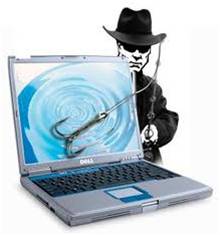Quick Introduction to Phishing
 The convenience of online commerce has been embraced by both consumers and criminals alike. Phishing involves stealing consumers’ personal identity data and financial account credentials. Social-engineering schemes use fake e-mails purporting to be from legitimate businesses to lead consumers to counterfeit websites designed to trick recipients into divulging financial data such as account and PIN numbers. Technical-subterfuge schemes plant crime-ware on PCs to steal credentials directly, often using systems to steal customers’ or organizations’ sensitive information.
The convenience of online commerce has been embraced by both consumers and criminals alike. Phishing involves stealing consumers’ personal identity data and financial account credentials. Social-engineering schemes use fake e-mails purporting to be from legitimate businesses to lead consumers to counterfeit websites designed to trick recipients into divulging financial data such as account and PIN numbers. Technical-subterfuge schemes plant crime-ware on PCs to steal credentials directly, often using systems to steal customers’ or organizations’ sensitive information.
Besides the obvious threats associated with phishing, other adverse effects include decreasing customer confidence in online commerce, and financial losses experienced by both businesses and consumers.
Although progress has been made in identifying threats and developing countermeasures, there has also been a simultaneous increase in attack diversity and technical sophistication in phishing and online financial fraud. Technical crime-ware resources are readily available and have been streamlined and automated, allowing for use by amateur criminals, making phishing economically viable for a larger population of less sophisticated criminals.
Latest Phishing Attacks
- Tab Napping - Imagine you open the login page for your Intranet portal, but then you open a new tab to visit another website for a few minutes, leaving the first tab unattended. When you return to your Intranet Portal the login page looks exactly how you left it. What you haven’t realized is that a fake page has taken its place, so when you type in your authentication credentials, you have inadvertently given the fraudster easy access to your account.
- Spear Phishing – This is a rising phenomena that uses official-looking e-mails to lure people to fake websites and trick them into revealing personal information. However, unlike traditional phishing, spear phishers do not send thousands of emails randomly, but target select groups with something in common—they work at the same company, bank at the same financial institution, attend the same college, order merchandise from the same website, etc. The e-mails are ostensibly sent from organizations or individuals the potential victims would normally get e-mails from, making them even more believable.
- URL Obfuscation – As users learn to detect fake emails and websites, phishers use techniques such as URL obfuscation to make phishing emails and sites appear more legitimate. This mechanism misleads the victims into believing that a link and/or web site displayed in their web browser or HTML-capable email client is that of a trusted site but are then redirected to a phishing site. For example, if the legitimate URL is www.login.example.com, the phishing URL may be www.login-example.com, thus tricking the customer into trusting the site by using an easily overlooked substitution.
- Filter Evasion – This is an another e-mail phishing attack where attacker sends mail with picture images attached to malicious websites to retrieve personal details.
- SMishing - Attacker uses SMS to launch phishing attack on cell phones to steal sensitive information. Scam message direct you to click on malicious banking websites or call a phone number. If you visit the link it downloads viruses into your system or if you dial the number will be asked for personal information.
- Specialized Malware – Over the last couple of years, malware has been increasingly used for criminal activity against users of online banking and commerce sites. Specialized malware available today can easily be reconfigured to target information from a number of different websites. Malware also provides several mechanisms for stealing data that is then used for identity theft or stealing money from a victim’s account.
Conclusion
Though people today are more aware of phishing, countermeasures need to be designed in order to deal with the increasing technical sophistication of criminals conducting phishing scams exploiting human vulnerabilities.
Phishing awareness needs to grow to include law enforcement and employees of targeted businesses so that they are able to accurately recognize scams targeting them. It is also important to remain vigilant by developing and enforcing countermeasures, making the resources for phishing both scarce and expensive with increased policing and thereby making phishing less profitable.
The message is clear - the key to protecting oneself starts with continuous education and awareness.
The Aujas Phishing Diagnostic Assessment can help your company assess and remediate phishing risks. For more information about the Diagnostic, or other Aujas services, contact Karl Kispert, VP of Business Development at 201 633 4745 or karl.kispert@aujas.com.
Related Articles
- Phishers Target Social Media, Are You the Victim? (aujasus.com)




